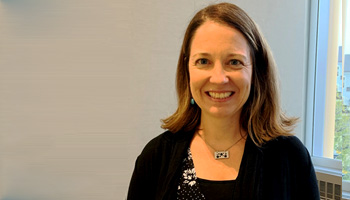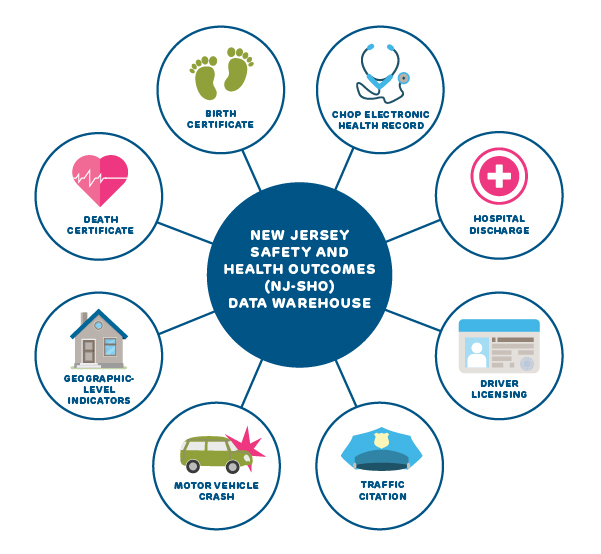HOW CAN WE HELP YOU? Call 1-800-TRY-CHOP
In This Section
New Data Warehouse Spurs Innovative Research

Allison Curry, PhD, leads the development of the NJ-SHO, a key resource that contains approximately 80 million records across eight different databases.
Looking at a crash report in a single database, researchers often get just a snapshot in time: they see who and what was involved, how the crash occurred, and the location and time of day. Less often, said Allison Curry, PhD, MPH, do researchers get the details to fill in the larger picture: How long has each individual involved in the crash been driving? Has this person been in crashes before? What other underlying factors may increase crash risk?
Previous research has shown that these questions matter – especially when it comes to understanding why crashes happen in order to help prevent them.
"Identifying crash risk factors and long-term outcomes for different drivers is enhancing our understanding of why and how crashes happen and is informing driver safety policy across the country,” Dr. Curry said.
According to research conducted by Dr. Curry and her team using the New Jersey Safety and Health Outcomes Data Warehouse (NJ-SHO), a young driver’s crash risk changes significantly during the first few years of driving, and young drivers with attention-deficit hyperactivity disorder (ADHD) are more likely to crash or engage in risky driving behaviors than those without ADHD. And older drivers tend to have a lower crash rate – but higher fatal crash rate – than middle-aged drivers.

The NJ-SHO contains 80 million records from eight administrative databases across New Jersey
Dr. Curry, who is an assistant professor of Pediatrics at Children’s Hospital of Philadelphia’s Center for Injury Research and Prevention (CIRP) and Division of Emergency Medicine, has led the creation of the NJ-SHO over the last decade, developing it into a key methodological contribution to advance injury prevention research and improve public health outcomes. This unique treasure trove of data links 80 million public health records for about 20 million NJ residents across eight administrative databases and counting, including driver licensing; motor vehicle crashes; traffic citations; childhood medical records; inpatient, outpatient, and emergency room visits; and vital statistics data.
Since it provides longitudinal information covering the pre- and post-injury period of a crash event, researchers have the opportunity to analyze and consider a number of potentially confluent factors such as age, licensing history, or medical background to answer urgent research questions that could not be previously addressed due to a lack of appropriate data.
"If we just had crash report data, we would have no idea what characteristics those who crashed share, and so, we have no idea how those characteristics are connected to crash risk and their long-term outcomes,” Dr. Curry said. "In a way that other databases don’t, the NJ-SHO gives researchers a rich history from which to draw, instead of just relying on what current crash reports provide. And, we keep building upon this data warehouse. It’s a resource that is constantly evolving.”
When Linking Databases Leads to Discovery
The findings that have resulted from tapping into the NJ-SHO over the years illustrate just how powerful the linking of data can be.
So far, Dr. Curry and her colleagues have published 25 peer-reviewed manuscripts and reports using the NJ-SHO that have had demonstrable impact on young driver safety at the national level. Dr. Curry also received numerous grant awards for this program, the most recent being a National Institutes of Health grant to measure driver exposure (the extent to which drivers actually drive) and develop methods to account for exposure in crash risk estimates.
But to understand the uniqueness of the NJ-SHO as a resource, Dr. Curry likes to go back to the story of one of her most rewarding undertakings related to the database: the building of foundational data for studies about driving with autism spectrum disorder (ASD).
Around 2015, Dr. Curry began to seek funding to study the extent to which adolescents on the autism spectrum get licensed to drive. She and a team of researchers from CHOP then connected CHOP electronic health records to state-wide licensing and crash data and were able to retrospectively follow pediatric patients. Linking these two databases, they showed that contrary to previous assumptions that autistic adolescents and young adults either do not drive, one in three teens with ASD were getting licensed.
"Prior to this study, we found that two-thirds of parents were interested in having their autistic teen drive. So this work highlighted the disconnect between the high proportion interested in driving and the much lower proportion who were actually driving,” said Dr. Curry, who published the findings in the journal Autism. "That suggested we really needed to understand what was at play in terms of influencing families’ driving-related decisions.”
Dr. Curry and her team are several years into a National Institute of Health grant that aims to better understand how families make decisions about transportation, including driving. She describes this work as one of her most rewarding research projects using NJ-SHO thus far: "Having the ability to provide foundational knowledge on licensing and crash rates among adolescents with medical conditions was when I truly got excited about expanding the data warehouse.”
Powering Up Partnerships Through Data Linkage
Since 2015, the NJ-SHO has fueled a myriad of studies both within the realm of driving safety and beyond. With more diverse data recently added to it, Dr. Curry continues to create collaborations on research that will truly benefit from linking health information across databases.
"I think the more hands that can be in these data, the more benefit it can have in advancing public health across different topics,” Dr. Curry said. "In the last few years, we have really tried to focus on figuring out how the NJ-SHO could help other researchers tell their stories the way we’re telling our stories. We’ve been able to conduct a lot of research aimed at improving driving safety; but adding in health information has exponentially increased the number of questions these data can answer, even beyond injury prevention.”
For example, Dr. Curry recently partnered with a team of researchers at New York University to gain insights into car crash trends involving school-age pedestrians and cyclists by examining differences in age and geography.
And currently, she is working with researchers at Brown University's School of Public Health on two studies that utilize multiple data sources. In the first study, which addresses health disparities due to license suspensions for non-driving related offenses, researchers at Brown are linking NJ-SHO data, Medicare/Medicaid data, and publicly available numbers on the factors that affect access to healthcare; this helps them determine the impact of licensing suspensions on health and well-being.
The second study hones in on the effects of medication on motor vehicle crashes in older adults. Previously researchers lacked data linking crashes, age-related medical conditions, and prescription drug use. With the NJ-SHO, the team can close that gap by joining licensing and crash histories from over two million drivers 65 and older with clinical and prescription drug data.
Alongside the external partnerships, Dr. Curry is equally proud of the cross-center collaborations fueled by NJ-SHO right here at home at CHOP, citing collaborators at the Center for Autism Research, PolicyLab, and the Center for ADHD Management.
"We’ve intentionally designed the NJ-SHO warehouse in a way that it can help answer novel research questions on numerous topics,” Dr. Curry said. "We’d love to collaborate with researchers who may be interested in using these data to help advance knowledge in their field.”
See a complete list of research projects that utilize the NJ-SHO, and learn more about the different databases linked in the warehouse.
Read a blog post by Dr. Curry about her collaboration with Brown University’s School of Public Health.